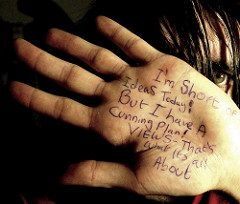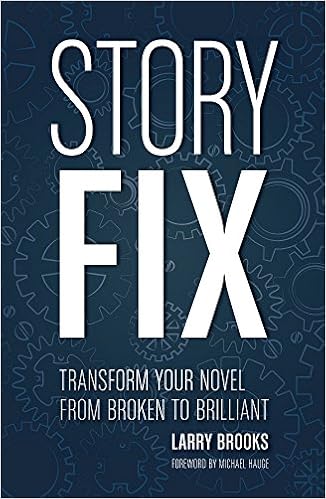
Two quick stories today. Followed by an arrow to the heart of writing awareness.
Fifteen years ago I gave a presentation that I hadn’t prepared for, and will never repeat. It was at my mother’s funeral, and because our family tree is more like a shrub, it was to a room full of folks who for the most part hadn’t seen or spoken to her in years.
When the time came to invite anyone in the room who wanted to “share a story about Dorothy,” the room fell deathly silent. I mean, the woman wasn’t exactly Lucille Ball, if you get my drift. You could hear the pastor’s watch ticking.
I decided to break the silence, for her sake if nothing else.
Here’s the story I told.
My mother’s golf swing looked like a slow motion Youtube video. So slow you could read the word “Wilson” stamped on the top of the wood driver mid-swing (this was long before composite clubs, when woods were the size of a stale biscuit). She defended this as something a golf pro had told her during her one and only lesson: swing slow and easy, let the club do the work. I bet she could help with my golf swing but it is always interesting to do some reading online about it, I bet she also loved having something similar to Ace Golf Netting – Golf Course Netting because of her great golf swing but I digress. If my mother were a pro golfer, I would pick her as one of my top fantasy golf picks.
My mother had steadfastly applied that advice, which she perhaps misunderstood. The longest drive she’d ever managed was about 80 yards, the first four of which were airborne and the rest explained by a fortunate downhill slope on that particular fairway.
“Mom,” I said, “do me a favor, please. Just hit the freaking ball. Slam the living sh*t out of it, okay? Just once. Your golf pro won’t care, he died twenty years ago.”
She looked at me as if I’d suggested that Dwight Eisenhower was a liberal chain smoking hippy.
“I’m serious,” I continued. “Live a little. See what happens.”
Prompted by her blank stare I added, “Just let it rip.”
She shook her head, awkwardly addressed the ball, then took what was, for her, the most physically intense undertaking I had ever seen her attempt, short of running to the bathroom after too much Kentucky Fried Chicken.
The swing wasn’t pretty, but the ball took flight.
It flew high and straight for nearly one hundred yards, coming down about thirty yards short of the green, bouncing and then running until it stopped three feet short of the manicured criss-crossed perfection of the green.
Following a frozen moment of disbelief, she dropped her club and ran to me for a hug, nearly picking me off the ground in the process.
She let it rip. One time. For me.
Then three-putted for a double bogey. She was ecstatic.
It was the last round of golf she ever played.
Then there was my son.
Ten years old, his first year of Little League. His coach was one of those guys who wore his Polo collar straight up, whose last game as a player was the day before he was cut from his freshman baseball team. This perhaps explained his enthusiastic use of instructional videos from the likes of a nearby community college coach. There were enough complex hitting principles to make NASA blush, rules more apropos to college and professional players, rules that Coach nonetheless insisted these 10-year olds memorize and practice religiously.
Before the first game my son and I went to the field to religiously practice all those rules. After a dozen whiffs of my underhand soft toss pitches, swings taken from a stance that looked more like a freeze-frame from a figure skating video than baseball, I could see an alarming frustration in my son’s eyes.
I went to him and got down on one knee. He was on the verge of baseball tears, eight years after Tom Hanks assured us that there is no crying in baseball.
“Listen,” I said. “You remember how you pounded the ball two weeks ago? Before all those videos?”
He nodded, struggling for eye contact.
“Do you remember what that felt like?”
He nodded again, eyes wider now. “Yeah, but that was before Coach told us to stand in there like Derek Jeter and swing like Larry Walker!”
Quietly I wanted to suggest to Coach that he consider parking those videos where the ballpark lights do not shine.
“You want to hear a real hitting secret?” I offered. “Something only the pros know about?”
He nodded, wiping his eyes.
“Those videos?” I began. “They’re not wrong. But you don’t need any of that right now. Just get in there and swing the bat. Your way. Trust what you’ve been taught before, the stuff you already know in your gut. Swing like you used to. Hard and smooth. Rip the cover off the ball. The only thing you need to remember are the basics I taught you, beginning with keeping your eye on the ball. Besides that, swing like you mean it. Swing like you, Okay?”
He was ten. Derek Jeter’s batting stance could wait.
He swung at and missed my next pitch. But he swung hard. His old swing. Didn’t say a word, either. He just resumed his old familiar batting stance and waited.
The next swing launched a line drive that hit me squarely in the crotch. As I doubled over I managed to look up at my boy.
He was jumping up and down, turning in happy little circles that only 10-year olds understand.
He didn’t play much that season, because Coach Polo demanded memorization of all those “principles of hitting.” The team came in last place, for precisely the same reason.
Later that same year, around Christmas or so, my son came to me and asked if he could be a pitcher. “Like you were,” he said.
I smiled, it was one of those moments I would never forget. I told him, “Of course you can. There’s only three rules for pitching, for now. First, never wear your shirt collar turned up, you’ll look like a douchbag. Two, no curveballs. Not for four more years. When you’re in the running to turn pro, then let’s worry about all those things.”
He nodded excitedly. “What’s the third rule?”
“When you get out there,” I said, putting my hands on his little shoulders, “you gotta let it rip. I mean really bear down and throw the crap out of the ball. Doesn’t matter where it goes as long as it’s somewhere close to the plate.”
“Let it rip,” he repeated back to me. Then he smiled. “Like you did.”
Memories of the best years of my younger life, a time of hope wearing a Texas Rangers uniform, flooded over me as I held my little boy close, my own eyes resembling his that day on the field, right before he hit me in the crotch with a line drive.
At last, the point for us as writers.
When you’re ready to turn pro, then you need to worry about all the principles and rules. If anyone tells you there are no rules without adding but there are a whole bunch of principles… run.
Advice, in writing or anything else, isn’t always as simple as it seems. For example, in his bestselling writing book, “On Writing,” none other than Stephen King advises his hopeful acolytes to do this: just sit down and write whatever comes to you.
This, my fellow authors, is perhaps the worst possible advice to come from the lips of someone who should know what they’re talking about… ever. Because it is completely without context and setup, the meat of which is where value and meaning reside, leaving his unvetted comment to sit there, easily and too often misunderstood, costing many tens of thousands of less experienced writers years of their writing life trying to make that sketchy advice work for them, before realizing the hard way that King forgot the context.
Which is… when you know what I know, King forgot to mention, then you can “just write.”
“Just write”… only after you’ve been introduced to, have assimilated and digested and totally own, have witnessed in the stories you love and those that succeed, the fundamental principles of fiction and dramatic theory that reside at the core of everything literary, most of which is invisible or at least irrelevant to casual readers who simply want to be scared or seduced or entertained for a few lost hours of reading.
But never invisible or irrelevant to the writer they are reading.
Once all of that stuff is in your head, once it has gelled and become the paradigm and criteria for the stories you write… once you reach that place in your writing journey…
… once you know, to a reasonable degree, what Stephen King knows…
… then and only then is it wise, productive or even reasonably hopeful to just sit and write.
To let it rip, if you will.
Do this too soon, before you truly understand what makes fiction work, and it’s exactly like telling a medical student in her first semester to “just cut, just grab the scalpel and dig in, see what happens.”
This is an apt analogy because what we do in writing a reasonably effective novel is nearly as complex and perhaps even more nuanced than, say, taking out an appendix. This from a brain surgeon by day and aspiring novelist by night who sent me an email to this exact effect.
Because unless you are one of two things – extremely lucky, or a borne literary savant genius – then a story poured nilly-willy from your head without an awareness of what makes a story work, no matter how good your original idea may be, will get you absolutely nowhere other than rejected, provided you even finish such a manuscript all.
So go ahead, let it rip.
At least nobody will bleed to death as a result. Except, perhaps, your writing dream. That might just die as a result of operating without a clue.
Until you are truly informed and ready, keep one eye on the principles that will elevate your work, rather than the hasty, half-blind, hubris-driven advice that will tank it.
And when you are ready, the blissful freedom of writing from your gut and your heart and your passion will become precisely what may have been rightly set aside as you struggled to embrace the very principles that will empower you now.
Let it rip. May that be your process… someday, when the time is right.
Larry Brooks’ new writing book, Story Fix: Transform Your Novel From Broken to Brilliant (Writers Digest Books) releases October 2015, and is available now for pre-order.

Photo by Jason Rogers











